Benchmarking GeForce GTX Titan 6 GB: Fast, Quiet, Consistent
We've already covered the features of Nvidia's GeForce GTX Titan, the $1,000 GK110-powered beast set to exist alongside GeForce GTX 690. Now it's time to benchmark the board in one-, two-, and three-way SLI. Is it better than four GK104s working together?
Results: Battlefield 3
Resolution: 1920x1080
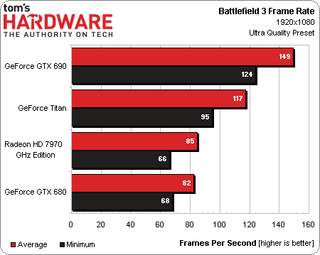
Mirroring the outcome of 3DMark, Battlefield 3 at 1920x1080 favors the GeForce GTX 690 first, Nvidia’s new Titan card second, and the Radeon HD 7970 and GeForce GTX 680 almost equally.
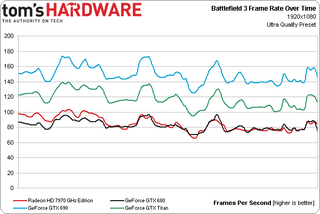
At least at 1920x1080, measuring frame rate over time only shows us that all four of these cards are plenty capable of maintaining minimums in excess of 60 FPS.
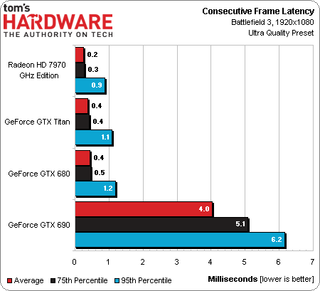
Our first outing of the consecutive frame latency chart requires some explanation. This metric is most useful for our single-GPU solutions—all of which show incredibly small variance in the time that passes between consecutive frames.
Nvidia’s GeForce GTX 690 looks like it doesn’t do well; however, 6 ms for a 95th percentile result is still very good. More important, though, is that Fraps cannot capture latencies across the entire graphics pipeline. We’ve gone back and forth with Nvidia on this, concluding that the 690’s result is only somewhat off. Any attempt to compare it against two Radeon cards in CrossFire would make analysis more problematic, since both architectures do different things after Fraps captures its data, adding variance between our numbers and what you’d actually see on-screen. We’ll keep this in mind as resolutions increase and consecutive frame time differences naturally increase.
Resolution: 2560x1600
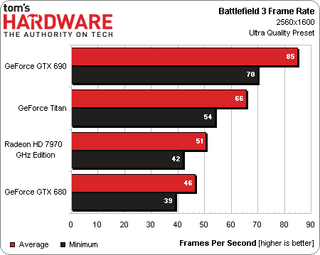
The GeForce GTX 690 maintains a large advantage over Titan at 2560x1600, reminding us that the $1,000 single-GPU card isn’t here to tell a value story. AMD’s Radeon HD 7970 GHz Edition extends its lead over the GeForce GTX 680 just slightly.
Stay on the Cutting Edge
Join the experts who read Tom's Hardware for the inside track on enthusiast PC tech news — and have for over 25 years. We'll send breaking news and in-depth reviews of CPUs, GPUs, AI, maker hardware and more straight to your inbox.

This graph looks a lot like what we saw at 1920x1080, shifted down. All four solutions still deliver performance we’d consider playable, only just kissing 40 FPS in the case of Nvidia’s GeForce GTX 680.
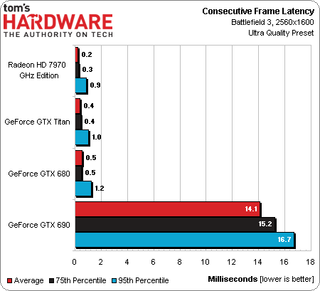
We continue to see tiny gaps between frames from our single-GPU cards, though the GeForce GTX 690 consecutive frame time difference more than triples, on average. However, the latencies are still so small, and the frame rates so high, that we would still consider this a good result.
Resolution: 5760x1200
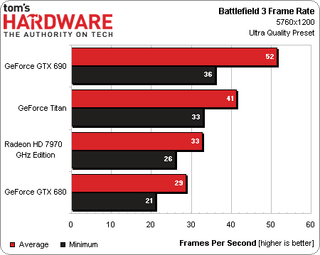
This is the resolution cards like GeForce GTX 690 and Titan are meant for, though the Ultra quality preset hammers all cards pretty hard. GeForce GTX 690 continues its match, besting the Titan. However, both boards see relatively similar minimum frame rates through our 90-second Fraps sequence.
The Radeon HD 7970 GHz Edition maintains its lead over the GeForce GTX 680, though we’d probably consider dropping the detail slider one notch on both boards in order to bring frame rates up a bit.
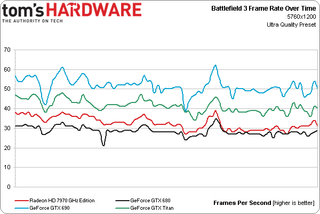
The GeForce GTX 680 gets hit once with a dip that takes its instantaneous frame rate down to 21. Otherwise it hovers between 25 and 35 frames per second. AMD’s Radeon HD 7970 GHz Edition stays ahead of it each step of the way.
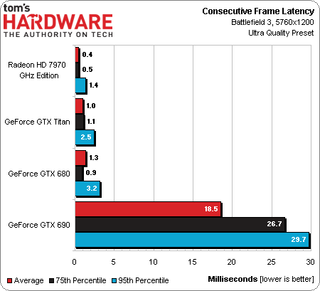
The 690’s consecutive frame latency is noticeably higher than the single-GPU solutions we tested, but it’s not distracting compared to the other cards. We have more work to do when it comes to defining the point where latencies affect your experience; that's a standard we're currently working on. In the meantime, we have the data here for reference.
Meanwhile, the single-GPU cards maintain fantastically-small latencies between consecutive frames.
-
Novuake Pure marketing. At that price Nvidia is just pulling a huge stunt... Still an insane card.Reply -
whyso if you use an actual 7970 GE card that is sold on newegg, etc instead of the reference 7970 GE card that AMD gave (that you can't find anywhere) thermals and acoustics are different.Reply -
cknobman Seems like Titan is a flop (at least at $1000 price point).Reply
This card would only be compelling if offered in the ~$700 range.
As for compute? LOL looks like this card being a compute monster goes right out the window. Titan does not really even compete that well with a 7970 costing less than half. -
downhill911 If titan costs no more than 800USD, then really nice card to have since it does not, i call it a fail card, or hype card. Even my GTX 690 make more since and now you can have them for a really good price on ebay.Reply -
spookyman well I am glad I bought the 690GTX.Reply
Titan is nice but not impressive enough to go buy. -
hero1 jimbaladinFor $1000 that card sheath better be made out of platinum.Reply
Tell me about it! I think Nvidia shot itself on the foot with the pricing schim. I want AMD to come out with better drivers than current ones to put the 7970 at least 20% ahead of 680 and take all the sales from the greedy green. Sure it performs way better but that price is insane. I think 700-800 is the sweet spot but again it is rare, powerful beast and very consistent which is hard to find atm. -
raxman "We did bring these issues up with Nvidia, and were told that they all stem from its driver. Fortunately, that means we should see fixes soon." I suspect their fix will be "Use CUDA".Reply
Nvidia has really dropped the ball on OpenCL. They don't support OpenCL 1.2, they make it difficult to find all their OpenCL examples. Their link for OpenCL is not easy to find. However their OpenCL 1.1 driver is quite good for Fermi and for the 680 and 690 despite what people say. But if the Titan has troubles it looks like they will be giving up on the driver now as well or purposely crippling it (I can't imagine they did not think to test some OpenCL benchmarks which every review site uses). Nvidia does not care about OpenCL Nvidia users like myself anymore. I wish there more people influential like Linus Torvalds that told Nvidia where to go.
Most Popular


